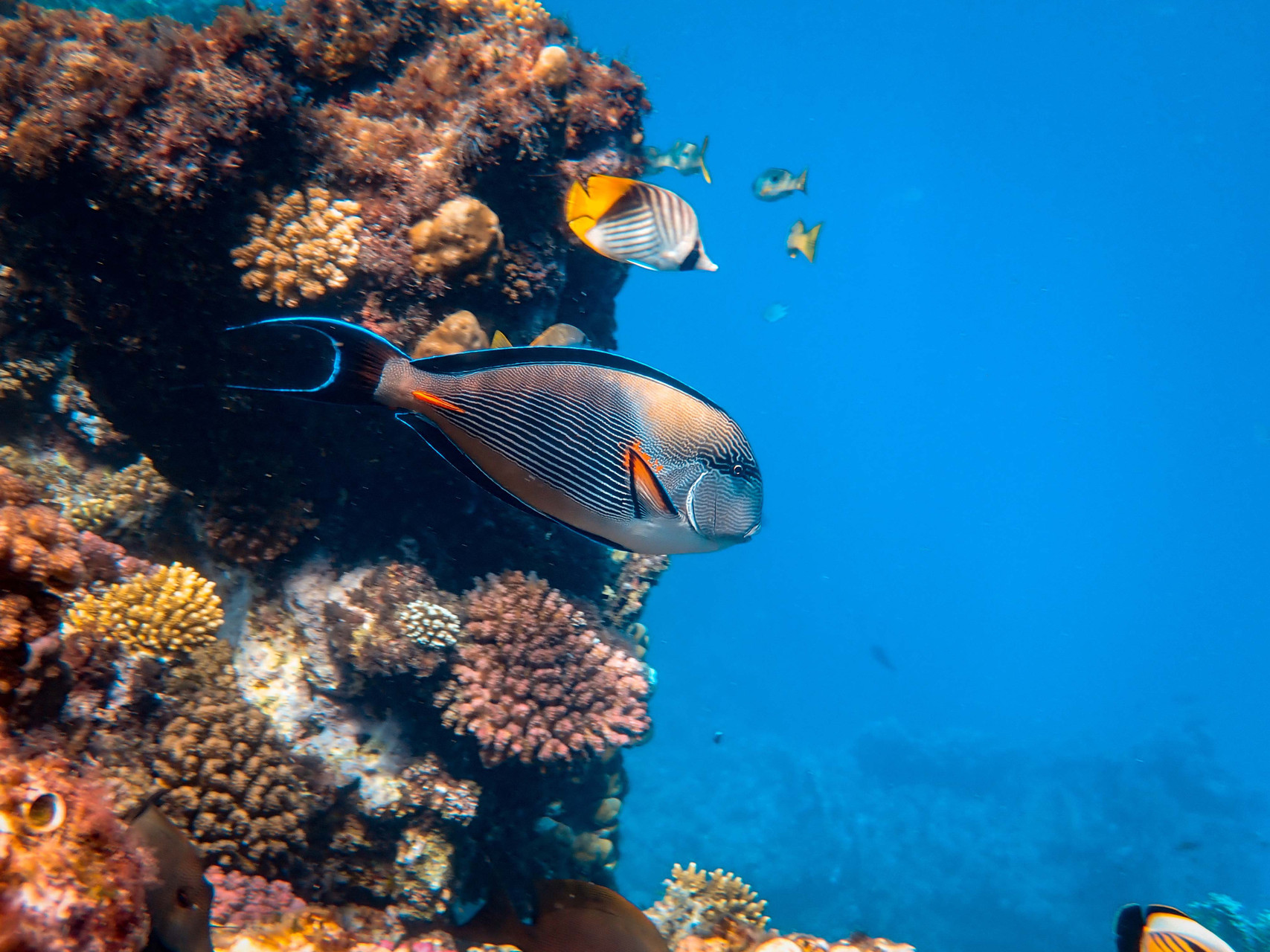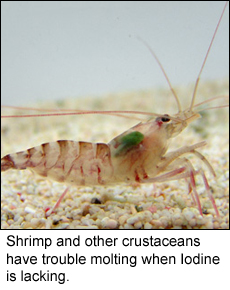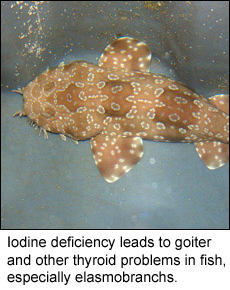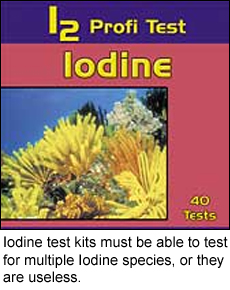Chemistry Corner, Your Guide To IODINE, part 1


What You Didnt Know That You Didnt Know
I love my job. It provides me the opportunity to completely immerse myself in one of my true passions, marine husbandry. I basically spend all day, everyday, studying up about how to be a better marine aquarist. And though, like many of my readers, I have years and years of experience, I am constantly humbled by the sheer plethora of topical information. Every time I start to think I have finally figured it all out, I uncover a new level of complexity of which I was unaware. Case in pointIodine. I thought I understood the role of Iodine in marine husbandry, as many readers may also believe. However, exhaustive research into the subject has redirected my thinking. I no longer fully understand the role of Iodine because, frankly, no one does!
Wholesale knowledge gaps, such as this one, actually make me happy. It is wonderful to think that our hobby is still coming into its own, leaving us so much more to learn. Each day with a marine aquarium is a day you have to discover something no one else ever has (or at least something no one else has ever told you). Iodine is a great example of a topic which needs to be better understood, and hopefully I can alleviate some of the confusion right here.
Iodine is not an easy subject to understand, and it certainly is not easy to write about. The complexity of the elements place in the marine environment has actually been undersold by aquarium literature. Many books and articles espouse unsubstantiated beliefs about the role of Iodine in marine systems, and most sources of information on the subject are anecdotal, at best. Of course, calling these facts unsubstantiated and anecdotal does not connote that they are wrong. It simply points out there is a lack of direct scientific data which corroborates certain conventional aquarium wisdoms.
Much of the understanding of the marine realm stems from fisheries science, because of the obvious economic benefits of fishing. Secondarily, pharmaceutical needs and academic curiosity also drive scientific understanding of the ocean. Unfortunately for aquarists, little scientific effort is extended specifically towards our hobby. A surprising percentage of our knowledge comes from someone stumbling upon it; when enough people experience the same results, we accept a new idea as fact. In the case of Iodine, aquarists have found out the hard way that its deficiency causes health problems in fish and certain invertebrates. It is widely reported that soft corals (especially pulsing ones), crustaceans, and fish all suffer from poor health when Iodine is lacking. We also know that macroalgae is a significant sink for this element. What we do not know is how our livestock absorbs Iodine. We also do not currently have a cheap, accurate way to test for it. Moreover, we still are not even sure what form is correct to provide. Though there are now many forms of supplemental Iodine available to aquarium keepers, the most prevalent form in use, Lugols, is a recipe from 1829! That we havent improved upon a recipe in 181 years calls our methodology into question. After all, Mr. Lugol surely did not have reef-keeping in mind when he first mixed one part Iodine (I2), two parts Potassium Iodide (KI), and 17 parts distilled water.

What We Do Know (or Think We Know)
Many of us are familiar with Iodine in its antibacterial capacity, as people have recognized its antiseptic qualities for generations. In fact, Iodine is stilled routinely used in hospitals to prepare surgical sites on patients. Aquarists, on the other hand, often dip new corals and polyps in Iodine solutions (usually a Lugols formulation) as a means to eliminate pests and parasites. Doing so is believed to help avoid introducing these harmful organisms into captive systems. Newly propagated polyps are also dipped to clean wounds caused by fragmentation. Again, these aquarium uses are not scientifically corroborated, but aquarists have been implementing them successfully for long enough to give them considerable substantiation. Whether or not Iodine dips confer a true benefit is less relevant than the fact they do not seem to be doing any harm, or else no one would do them. Besides, from an intellectual perspective, the logic behind the process is fairly sound. Accordingly, such techniques are considered to be staple procedures and are nearly ubiquitous in husbandry publications.
Iodine itself can also be considered ubiquitous in the ocean, not only since it occurs naturally, but also because some form of it is present in measurable quantities in virtually every known marine organism. Scientists have confirmed that, at the very least, Iodine is found in bacteria, algae, corals, worms, crustaceans, and fish. Each type sequesters a differing quantity of the element, but requires some amount nonetheless. Thus, from a biological perspective, we know that Iodine is useful. How and why it comes to be in so many organisms is the subject of much conjecture, however.
Why is Iodine So Hard to Pin Down?
To understand the source of the confusion, we must first understand that elemental Iodine has the ability to form numerous ionic compounds in seawater. I2 is rare in seawater because it quickly changes it other forms. In general, there are two basics forms of ions and compounds, organic and inorganic. The difference between the two is the presence of a carbon atom. Organic compounds contain carbon, while inorganic ones do not, and both types play important roles in biological processes. Counterintuitively, inorganic forms are especially critical because they represent the beginning of the chemical pathway. On the other hand, organic Iodine complexes are often the byproducts of chemical reactions initiated with the inorganics.
Inorganic forms of Iodine can make up more than 60% of the Iodine in seawater, which is usually concentrated at 0.06 mg/L. The two most important types are Iodate (IO3-) and Iodide (I-). The majority of research regarding Iodate and Iodide uptake in marine organisms has centered around macroalgae. Due to the preponderance of nuclear activity in the 20th century, radioactive Iodine isotopes have made their way into macroalgal tissues, where they can be accurately measured by researchers. Researchers have further capitalized on this fact by recreating the scenario in laboratories. Unfortunately, such information has only elicited more questions than answers. It seems that Iodate and Iodide are both taken up and stored by macroalgae, however scientists are not sure how or why. It has been shown that Iodide is preferential for macroalgae, and that phytoplankton quickly convert Iodate into Iodide. In hypoxic zones, bacteria also facilitate the Iodate/Iodide conversion.
For other marine organisms Iodine, or lack thereof, has been implicated in deadly afflictions. For example, shrimp and some other crustaceans may become unable to undergo ecdysis (molting), the process by which they shed old exoskeletons. They may also die while attempting to molt. Fish, especially sharks/elasmobranchs, can suffer from goiter and thyroid problems due to Iodine deficiency. Interestingly, Iodine is even implicated for thyroid problems and other health issues in human being as well, as it is a necessary component of critical hormones such as triiodothyronine and thyroxine. It is thus reasonable to assume that Iodine plays a critical metabolic role in all living organisms, though such comprehensive data surely will not exist for some time, if ever.
Others examples of Iodine use in the marine realm include organisms of lower order, and are often poorly understood. Corals and their allies create a number of organoiodine compounds of unknown use. In photosynthetic corals, it has been postulated that these molecules eliminate excess oxygen and peroxide compounds, which are highly oxidative byproducts of photosynthesis. Excessive oxidizers may irritate coral tissues and interfere with zooxanthellate metabolism. Regulating the concentrations of such dangerous molecules therefore enables the polyps symbiotic algae to continue to photosynthesize in relative safety. Some gorgonians, antipatharians (black corals), and sponges create organoiodine compounds as well. Again, the reason why is unclear; however, there could be an antipredatory effect. This is especially true of sponges, where some of the compounds are quite toxic. For unknown reasons, some gorgonians even create the vertebrate hormone thyroxine, as do tunicates. Equally mysterious is why soft corals, especially pulsing genera like Anthelia, Cespitularia, Xenia, and Heteroxenia concentrate high levels of Iodine in their tissues.
What Else Could We Possibly Need to Know About Iodine?
It seems like we have covered a lot of ground in this article, and indeed we have. Yet, we have really only skimmed the surface of the Iodine issue. In next weeks installment of Chemistry Corner, we will address the regulation of Iodine as it pertains to marine husbandry. Unfortunately, it is not as simple as just dosing it. If too little Iodine is harmful, too much is equally so! Iodine supplements are notoriously unpredictable and may not contain the most useful ionic species. Moreover, test kits are usually unreliable and sometimes test for the wrong Iodine form. Complicating the problem is the unusually quick export of the element from aquarium systems, and the unknown input of food items. We will cover it all, next week.

Works Cited:
Cunningham, J. Iodine Addition to the Marine Aquarium. Aquarists Online. 2007. URL: < http://www.aquaristsonline.com/blog/aquarium-care...>
Goemans, B. and L. Ichinotsubo. The Marine Fish Health and Feeding Handbook. T.F.H. Publications; Neptune City. 2008.
Gozlanan, R. S. and D P. Margalith. Iodide Oxidation by a Marine Bacterium. Journal of Applied Microbiology. 36:3. pp. 407-417. 1973.
Henderson, N. E. and F.L. Lorscheider. Thyroxine and protein-bound iodine concentrations in plasma of the pacific hagfish, Eptatretus stouti (Cyclostomata). Comparative Biochemistry and Physiology Part A: Physiology. 51:4. pp. 723-724. 1975.
Hirano, S., T. Ishii, R. Nakamura, M. Matsuba, and T. Koyanagi. Chemical Forms of Radioactive Iodine in Seawater and its Effects Upon Marine Organisms. Radioisotopes. 32:7. pp. 319-322. 1983.
Holmes-Farley, Randy. Chemistry and the Aquarium Iodine in Marine Aquaria: Part I. Advanced Aquarist Online Magazine. Mar., 2003. 2003. URL: < http://www.advancedaquarist.com/issues/mar2003/ch...>
Sherrill, J., B.R. Whitaker, G.T.F. Wong. Effects of Ozonation on the Speciation of Dissolved Iodine in Artificial Sea Water. Journal of Zoo and Wildlife Medicine. 35:3. pp. 347-355. 2004.
Shomon, M. Iodine and the Thyroid. About.com Online. 2003. URL: < http://thyroid.about.com/cs/vitaminsupplement/a/i...>
Tullock, J.H. Water Chemistry for the Marine Aquarium. Barrons: Hauppauge. 2002.
Tullock, J.H. Natural Reef Aquariums. T.F.H. Publications; Neptune City. 2001.
Williams, K. Reef Tank Additives. Southwestern Michigan Aquarist's Magazine. 1994. URL: < http://www.swmas.org/swam/articles/reef_tank_addi...>